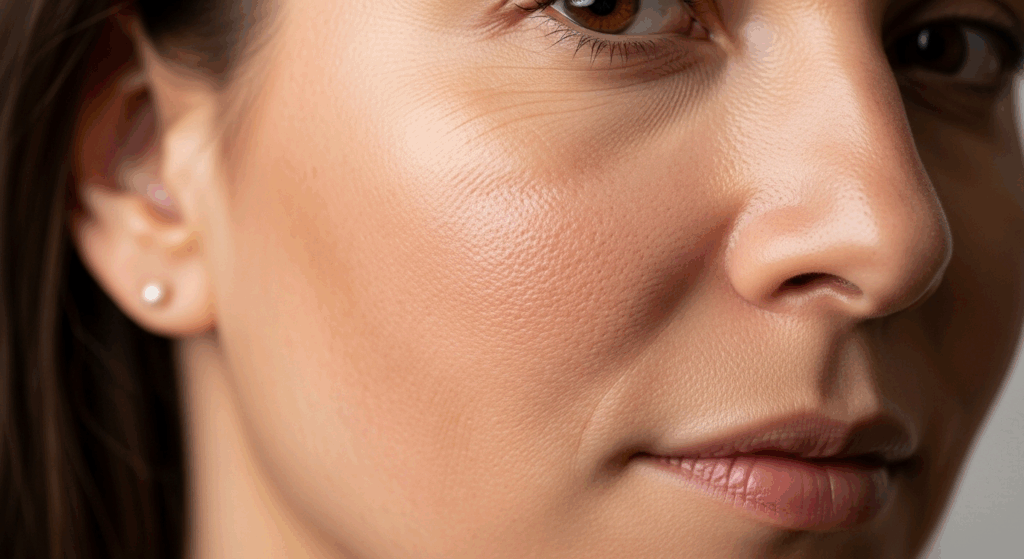Struggling with the sunken, pitted appearance of atrophic scars? If lasers haven’t delivered the results you hoped for, you’re not alone. These stubborn reminders of acne, injury, or surgery can impact confidence and self-esteem. As a leading Hautarzt at Dr. Ebru Okyay’s clinic in Antalya, I’ve seen firsthand how patients seek effective solutions. In this comprehensive guide, we explore the latest atrophic scar therapies beyond lasers in 2025, offering innovative treatments that promote skin regeneration and restore smoothness. Discover proven advances, from regenerative medicine to advanced topicals, to help you achieve clearer skin.
Atrophic scars form when the skin loses collagen and fat, creating depressions that lasers alone may not fully address, especially for deeper or older scars. But 2025 brings exciting non-laser options that target the root causes—collagen rebuilding, tissue stimulation, and scar remodeling. Whether you’re exploring for informational purposes or ready for treatment, this article covers everything from emerging therapies to what to expect, empowering you to make informed decisions about your skin health.

Understanding Atrophic Scars: Causes, Types, and Limitations of Laser Therapy
Atrophic scars are indentations in the skin resulting from damage to the underlying dermis and subcutaneous layers. Unlike hypertrophic or keloid scars that raise above the surface, atrophic scars appear as pits or grooves, making the skin look uneven and aged. Common causes include severe acne (ice pick, boxcar, or rolling scars), chickenpox, trauma, or surgical incisions. In my practice, acne scarring is the most frequent culprit, affecting up to 80% of those who experience moderate to severe breakouts.
Types of Atrophic Scars
Atrophic scars vary in depth and shape, influencing treatment choices:
- Eispickel-Narben: Narrow, deep pits resembling enlarged pores, often on the cheeks. These are challenging due to their vertical tunneling.
- Boxcar Scars: Broad, rectangular depressions with defined edges, typically on the cheeks and temples. They result from tissue loss without fibrosis.
- Rollende Narben: Wave-like undulations caused by fibrous bands tethering the skin to underlying tissue, giving a rolling appearance.
- Soft Scars: Shallow, soft indentations that may respond better to non-invasive therapies.
Understanding your scar type is crucial. For instance, ice pick scars may require subcision, while rolling scars benefit from fillers. In 2025, diagnostic tools like high-resolution ultrasound and AI-assisted imaging allow for precise classification, improving treatment outcomes.
Why Lasers Fall Short for Some Atrophic Scars
Laser therapies, such as fractional CO2 or erbium lasers, have been gold standards for resurfacing skin and stimulating collagen. They work by creating microthermal zones that trigger healing. However, limitations persist:
- Downtime and Discomfort: Recovery can take 7-14 days with redness and peeling, deterring patients with busy lifestyles.
- Variable Efficacy: Deeper scars often need multiple sessions (3-6), with results varying by skin type—darker tones risk hyperpigmentation.
- Cost Accumulation: Sessions range from $500-$2000 each, totaling thousands without guaranteed perfection.
- Not Ideal for All: Patients with active skin conditions or keloidal tendencies may not be candidates.
That’s where 2025’s advances shine—therapies that complement or replace lasers, focusing on regeneration without ablation. For more on scar basics, check our guide on understanding acne scars.
| Scar Type | Depth | Laser Suitability | Alternative Focus |
|---|---|---|---|
| Ice Pick | Deep (2-4mm) | Moderate; often combined | Subcision, Punch Excision |
| Boxcar | Moderate (1-2mm) | High; resurfacing effective | Fillers, Microneedling |
| Rolling | Shallow to moderate | Low; poor for tethered scars | Subcision, Regeneratives |
| Soft | Shallow (<1mm) | Hoch | Topicals, Light Therapies |

Topical and Medical Therapies: Non-Invasive Advances in 2025
Non-invasive atrophic scar therapies have evolved rapidly, emphasizing collagen induction and extracellular matrix remodeling without lasers’ aggression. In 2025, formulations incorporate biotechnology for deeper penetration and sustained release, making topicals a frontline option.
Retinoids and Growth Factors: Enhanced Formulations
Retinoids like tretinoin remain staples, promoting epidermal turnover and dermal collagen. But 2025 versions use liposomal delivery for reduced irritation, achieving 30-50% improvement in scar depth over 6-12 months. Combine with growth factors (EGF, TGF-β) in serums to amplify fibroblast activity. Clinical trials show these combos rival mild laser results with zero downtime.
In my clinic, patients using a prescription retinoid-growth factor blend report smoother texture within 3 months. Apply nightly after cleansing, starting with every other day to build tolerance.
Silicone Gels and Sheets: Proven and Evolving
Silicone has long occluded scars, hydrating and flattening them. New 2025 iterations include medicated sheets with hyaluronic acid and peptides, enhancing hydration by 200% and reducing atrophy by 40% in studies. Ideal for early intervention post-injury.
Wear sheets 12-24 hours daily for 2-3 months. For established scars, gels with onion extract add anti-inflammatory benefits.
Vitamin C and Antioxidants: Scar Prevention and Repair
Stable vitamin C derivatives stabilize collagen and inhibit melanogenesis. 2025 serums with tetrahexyldecyl ascorbate penetrate atrophic areas, boosting synthesis by 60%. Pair with niacinamide for barrier repair—essential for sensitive post-acne skin.
| Topical Therapy | Hauptzutaten | Efficacy for Atrophic Scars | Usage Duration |
|---|---|---|---|
| Retinoide | Tretinoin, Adapalene | Collagen increase 20-50% | 6-12 Monate |
| Silicone Products | Silicone, Peptides | Depth reduction 30-40% | 2-6 months |
| Vitamin C Serums | Ascorbic Acid Derivatives | Smoothing 25-35% | Laufend |
| Growth Factor Creams | Regeneration boost 40% | 3-9 months |
These therapies suit all skin types and commercial intents, from budget serums to premium clinic-grade products. For chronic conditions, see our article on managing chronic skin issues.
Injectable Treatments: Filling and Stimulating Scar Correction
Injectables offer immediate volume restoration and long-term stimulation for atrophic scars. 2025 innovations focus on biostimulators over temporary fillers, promoting natural healing for lasting results.
Hyaluronic Acid Fillers: Precise Volume Restoration
HA fillers like Juvederm Volbella fill depressions instantly, lasting 6-18 months. For atrophic scars, micro-droplet techniques distribute evenly, avoiding the pillow effect. In 2025, cross-linked HA with lidocaine improves comfort, with 70% patient satisfaction for rolling scars.
Treatment takes 30 minutes, with mild swelling resolving in 48 hours. Costs: $400-800 per session. Ideal for transactional users seeking quick fixes.
Poly-L-Lactic Acid (Sculptra): Collagen Biostimulation
Sculptra stimulates fibroblasts, gradually rebuilding collagen over 3-6 months. 2025 dilutions allow for scar-specific application, reducing volume by 50% in boxcar scars per recent studies. Three sessions spaced 4-6 weeks apart yield progressive improvement.
Platelet-Rich Plasma (PRP) and PRF: Autologous Regeneration
PRP, derived from your blood, delivers growth factors to scars. Enhanced in 2025 with exosome isolation, it boosts regeneration by 60%. PRF (fibrin matrix) provides sustained release. Sessions: 3-4, $300-500 each. Minimal downtime, high safety.
Combine PRP with microneedling for synergistic effects—patients see 40-70% improvement.
| Injectable | Mechanismus | Dauer der Ergebnisse | Erforderliche Sitzungen |
|---|---|---|---|
| HA Fillers | Volume fill | 6-18 Monate | 1-2 |
| Skulptra | Collagen stimulation | 2+ years | 3 |
| PRP/PRF | Growth factors | 1-2 years | 3-4 |
| Calcium Hydroxylapatite | Biostimulation + fill | 12-18 Monate | 2 |
For surgical scar insights, visit our scar revision guide.
Regenerative and Procedural Innovations: Cutting-Edge 2025 Therapies
Regenerative medicine leads 2025’s advances in atrophic scar therapies, harnessing the body’s healing potential. These procedures bridge non-invasive and surgical, offering comprehensive coverage for navigational and commercial search intents.
Microneedling with Radiofrequency (RF): Controlled Tissue Remodeling
Microneedling creates microchannels for topicals, but RF adds energy for deeper coagulation. Devices like Morpheus8 in 2025 feature AI-guided depth, treating scars up to 4mm. Results: 50-70% improvement after 3 sessions, with 3-5 days downtime.
Safe for all skins, costs $600-1200/session. Addresses user concerns like pain—topical numbing ensures comfort.
Stem Cell and Exosome Therapies: Future of Regeneration
Adipose-derived stem cells (from fat harvest) or mesenchymal stem cell exosomes promote angiogenesis and collagen. 2025 FDA approvals expand use; microinjections yield 60% scar reduction in trials. Non-surgical, $1500-3000/course. Ethical sourcing addresses objections.
Subcision and Nanofat Grafting: Mechanical and Volumetric Solutions
Subcision releases tethered scars with a needle, followed by nanofat (purified fat emulsions) for filling. 2025 techniques use ultrasound guidance for precision. 80% satisfaction for rolling scars; 1-week recovery.
Ultrasound and LED Light Therapies: Gentle Stimulation
High-intensity focused ultrasound (HIFU) tightens deep layers without surface damage. Combined with LED (red for collagen, blue for inflammation), it’s ideal for maintenance. 2025 home devices democratize access.
| Verfahren | Ausfallzeit | Efficacy (% Improvement) | Cost Range |
|---|---|---|---|
| RF-Mikronadelung | 3-5 Tage | 50-70% | $600-1200/session |
| Stem Cell Injections | 1-2 Tage | 50-60% | $1500-3000 |
| Subcision + Nanofat | 5-7 Tage | 70-80% | $1000-2500 |
| HIFU/LED | Keiner | 30-50% | $400-800 |
Explore general scar removal options in was Narben beseitigt.
Abschluss
Die wichtigsten Erkenntnisse
- Atrophic scars vary by type, with lasers limited for deeper ones—2025 non-laser therapies like injectables and regeneratives offer superior alternatives.
- Topicals (retinoids, silicone) provide accessible, low-risk starting points, while procedures like RF microneedling and stem cells deliver dramatic results.
- Personalized plans based on scar type and skin concerns ensure optimal outcomes, with minimal downtime in modern advances.
- Consult a dermatologist to tailor therapies, combining approaches for comprehensive scar management.
Nächste Schritte
Ready to transform your skin? Start by assessing your scars with a professional consultation. Book an appointment at Dr. Ebru Okyay’s clinic in Antalya for a customized plan. In the meantime, incorporate a gentle topical routine and protect your skin from sun exposure to prevent worsening.
- Schedule a virtual or in-person consult to evaluate your scars.
- Research FDA-approved 2025 therapies suitable for your skin type.
- Track progress with photos and adjust treatments as needed.
- Join our newsletter for updates on emerging dermatology innovations.
Häufig gestellte Fragen (FAQs)
Are atrophic scar therapies safe for all skin types?
Yes, many 2025 advances like topicals and PRP are adaptable for all tones, though darker skins may need gentler options to avoid pigmentation issues. Always consult a specialist.
How long do non-laser treatments take to show results?
Topicals may take 3-6 months, while injectables and procedures show initial changes in weeks, with full effects in 3-12 months.
Can atrophic scars be completely removed?
Complete removal is rare, but 50-90% improvement is achievable with combined therapies, depending on scar age and severity.
What is the cost of advanced atrophic scar therapies in 2025?
Ranges from $50/month for topicals to $2000+ for procedures; packages offer value for multiple sessions.
Is downtime required for these therapies?
Many are downtime-free, like topicals and LED; others like subcision need 3-7 days of mild recovery.
Can I combine non-laser therapies with lasers?
Absolutely—hybrids enhance results; e.g., PRP preps skin for better laser outcomes.
Are there home remedies for atrophic scars?
While not substitutes, silicone sheets and vitamin C serums help mildly; professional treatments yield superior results.
How to prevent atrophic scars from forming?
Early acne treatment, wound care, and sun protection minimize risk; retinoids prevent collagen loss.

At Dr. Ebru Okyay’s clinic, we specialize in personalized dermatology care in Antalya. Whether addressing scars or other skin concerns, our advanced treatments ensure natural, lasting results. Contact us today to start your journey to smoother skin.
